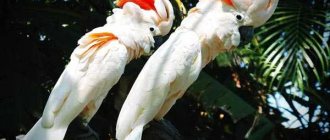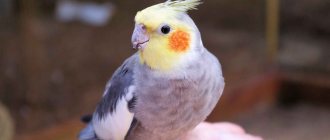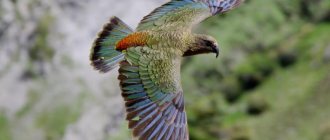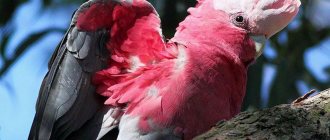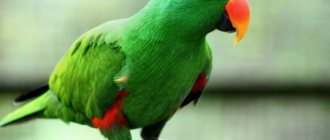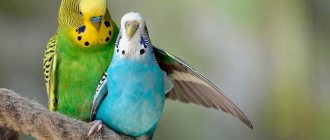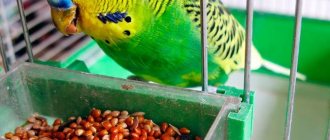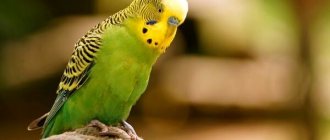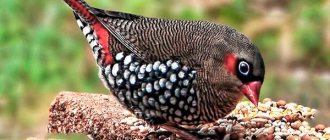Budgerigars are very cute, friendly and positive creatures. Anyone who has a couple of such beautiful birds at home has acquired a constant state of good spirits and a joyful mood.
However, if you decide to care for budgies, you need to do a lot of research. There are a large number of nuances in caring for these parrots. You should know everything about birds. Including how much a budgie weighs. It would seem that you can approximately find out the weight of a budgie by picking it up. But this is not enough. In order to properly monitor the health of your birds, you should know exactly how much your budgie weighs. Its normal average weight is 40-50 g. A young parrot can weigh less than 40.
Appearance and dimensions
Budgerigars have a beautiful and memorable appearance. These are harmoniously built compact birds, the body length of which does not exceed 22 cm. An adult weighs 40-45 g. The birds received their name for the lace pattern consisting of dark lines in the form of waves on the head and wings. Young parrots also have this pattern, but it seems a little blurry.
The long and straight tail makes the budgerigar look larger than it actually is. Its size is almost half the length of the body and is about 10 cm. It consists of three tiers of feathers. Juveniles have a much shorter tail.
The strong beak has a slight bend. At its base there is a cere on which the nasal openings are located. This part of the body has a different shade in males and females. It is used to determine the gender of the parrot:
- in adult males the cere is blue or purple;
- the female has blue or brown.
The parrot's beak is quite mobile, since its upper part is attached to the skull by tendons. The stratum corneum in adult birds has an olive tint. The chicks have a dark or yellowish beak. This part of the body helps birds in many ways:
- grasp, hold and carry small objects;
- clean and grind food - branches, fruits and seeds;
- climb trees and other surfaces;
- defend.
The budgerigar has eyes on both sides of its head. The bird has monocular vision. If the wavy needs to look at a small object, then he must tilt his head and examine the thing with one eye. Monocular vision is more than compensated by neck mobility.
Budgerigars see the world around them in color. They have a third eyelid, the so-called nictitating membrane. It protects the eyeball from drying out and dirt. The parrot does not have eyelashes; instead, there are small semi-feathers that prevent dust from entering the organs of vision. The budgie's ears are located just below the eyes and closer to the back of the head.
The wingspan of birds of this species reaches 20 cm. The body is supported on thin but strong legs, which are equipped with four fingers. Two face forward, the other faces backward. This structure of the limbs allows parrots to tightly grasp branches and climb trees.
Colors
According to the description, the budgerigar's natural color is light green. This is the color of the cover on the body. The bird's head and wings are lemon yellow with dark splashes in the form of wave-like patterns. The budgerigar's feathers are yellow on the face and upper neck.
Elongated blue or purple spots stand out on the sides of the head. There are several dark spots on the throat. Thanks to their natural coloring, green budgies can easily hide in dense thickets from enemies. This helps them survive in their natural habitat.
Thanks to selective breeding, today there are approximately 32 primary mutations in the colors of budgerigars, from which more than 100 secondary mutations have arisen. Knowledge of the laws of genetics allows even simple bird lovers to breed pets with the desired feather color. Common colors of budgies:
- blue;
- mauve;
- violet;
- clarified;
- anthracite;
- opaline;
- star-shaped;
- yellow;
- grey-winged;
- cinnamon;
- motley.
In 1872, scientists first introduced the yellow wavy to the world, and 6 years later blue parrots were bred. A little later we managed to get birds with blue colors. In 1917, white representatives of this species appeared, and in 1924, albinos and owners of variegated colors appeared. There are even black budgies. They look unusual, which is why they are popular in European countries.
Attention! Budgerigars are crested, and there are 3 types of crests - in the form of a bunch, round and semicircular.
Parameters of an adult bird
Corella is a bird belonging to the cockatoo family, the only representative of its species. These parrots are similar to cockatoo parrots in body structure and crest on the head.
Cockatiels reach adult size within two months, but most growth is completed by one month. The next month the birds no longer gain body weight, but continue to grow in length. More precisely, their feathers continue to grow.
After the cockatiel is about two months old, its size should correspond to that of an adult bird. The length of the parrot's body including the tail is thirty to thirty-three centimeters. Moreover, the length of the tail varies from fourteen to sixteen centimeters. The wingspan is seventeen to eighteen centimeters.
In size, the cockatiel is similar to a small pigeon. its weight should be approximately one hundred grams. But these are approximate values. Each parrot is individual and develops differently. If one at the age of two months still weighs eighty grams, the other gains one hundred and fifty.
It all depends on the conditions of detention and proper care. Too much underweight can be explained by the fact that the bird is either malnourished or sick. Excessive weight gain is also not the norm. Most likely, such a pet is obese.
The development of such a pathology depends both on the excess amount of food consumed by the bird per day, and on an improperly balanced diet. Perhaps there is too much protein in the bird's diet, or the owner is feeding the pet food from his table, which is strictly prohibited.
Character and habits
Budgerigars have a good memory and can speak. They do not have vocal cords, so birds reproduce sounds using their tongue. Birds can remember and repeat about 100-150 words and phrases.
The temperament characteristics of budgerigars are ambiguous. Their habits and behavior are sometimes unpredictable. These are birds with changeable moods. They either chirp and play pranks cheerfully, then suddenly become passive and do not respond to communication. However, you can find a common language with them, but you need to give the pets time to get comfortable in a new place and get used to their owner.
Budgerigars love to make noise, this should be taken into account by those who want to have a winged friend. They chirp loudly when someone is talking or watching TV. The birds are most active in the morning and evening hours. To prevent the feathered friend from interfering with sleep, the cage is covered with light-proof fabric in the evening.
Budgerigars that have not reached the age of five months can easily learn to talk. One of the main conditions for achieving success in this business is trust in the owner and regular practice. It is advisable to start with one word or phrase, usually the pet's name. It is important to do this every day for 10-15 minutes. The achievements of your feathered friend should not be ignored - you need to reward the parrot with treats.
Attention! You cannot skip classes on teaching birds to talk. At first, it may seem like there are no results, which is why many people give up. But you need to be patient - some parrots learn faster, others slower. After some time, the pet will definitely start talking.
Blue and yellow macaw
The feathered bird has very bright plumage and at first sight wins the love of people.
This is also a large representative of the species with a body length of up to 95 centimeters and a body weight of up to a kilogram. The upper part of the breast is bright blue, the rest of the body is orange-yellow. Against a contrasting background, the bird looks inimitable. A distinctive feature is the extraordinary mind, which allows the bird to learn words and even sentences without problems. Loves to communicate with people or other parrots. This is one of the most popular breeds of birds purchased as pets. Owners note a loud voice, a persistent desire to be in charge and a constant demand for attention as the main disadvantages of the breed. But these problems can be eliminated thanks to education, especially if you do it immediately after purchasing a young chick. You will have to pay at least one and a half thousand dollars for the purchase.
Habitat and lifestyle
Budgerigars are native to Australia. The birds are native to the southwest and east coasts and are found on nearby large and small islands. Birds choose steppe and semi-steppe zones for themselves. In the north of the mainland, where forests are very dense, wavy plants are rare.
Parrots gather in numerous flocks. Each of them can number several dozen or even hundreds of birds. They often change their location to find areas rich in food and water. It is not difficult for budgerigars to overcome huge distances, as they move very quickly. Their flight speed can reach 100-120 km/h.
In recent decades, the population of wild budgerigars on the Australian continent has declined sharply. People who interfere with nature and destroy it are to blame for this.
Brilliant Laurie
A fairly common species of birds that lives in the forests of China, India and New Guinea.
Loris have bright plumage, but their body structure is similar to ordinary chickens. The body length is from 30 centimeters to half a meter. Females are slightly smaller than their chosen ones. The price of a parrot ranges from 250 to 600 dollars; it can be purchased at a specialized nursery or from a professional breeder. They are quite easy to train and learn human speech. The main thing is to pay enough attention to the bird.
Nutrition
In the wild, budgerigars eat mainly food of plant origin. One of their favorite delicacies is the seeds of various plants, as well as grains. They love to eat fruits, vegetables, berries, and grass. They sometimes feast on small insects and invertebrates.
At home, wavy fish are fed grain mixtures. It’s good if you have succulent food in your diet:
- nettle;
- dandelion;
- fresh carrots;
- apple;
- pumpkin.
Birds should receive mineral supplements - sepia, chalk. List of prohibited foods for parrots:
- candies;
- baked goods and bread;
- avocado;
- sausages;
- Red beetroot.
Cockatoo alba
The second name of this bird is white-crested.
The body length of an adult bird reaches half a meter. Sometimes there are individuals up to 70 centimeters in size, but they are not common. The popularity of this species is due to its very beautiful plumage, as well as constant activity and the ability to repeat human speech and perform various tricks. Alba cockatoos love their owners very much, constantly require their attention, love to hug and caress. Due to loneliness, they attract attention by loud chirping. The price ranges from one thousand seven hundred to two and a half thousand dollars.
Reproduction and offspring
In nature, budgies can breed when the ambient air temperature exceeds +15 degrees, and the length of daylight increases to 12-13 hours. Birds nest in tree hollows. After mating, the female lays 4-12 eggs, which are covered with a white shell. The incubation process lasts about 18 days.
While the female sits in the nest, the male obtains food and feeds the expectant mother. Budgerigar chicks hatch completely helpless. Their weight does not exceed 2 g, they do not see or hear anything, and there is no feathering on their body.
After 10-11 days, the chicks' eyes open. Around this time, a rumor appears. The body gradually becomes covered with feathers. Until the age of one month, small wavy birds stay in the nest and then leave it.
Table. 2. Weight of cranes.
| View | Floor | Age (years) | Weight (g) | number of birds | ||
| Max | Min | Wednesday | ||||
| Siberian Crane (Grus leucogeranus) | Males | 1,5 — 23 | 9220 | 6700 | 7811 | 10 |
| 0,5 | 7100 | 5770 | 6446 | 5 | ||
| Females | 5 — 21 | 7590 | 6730 | 7178 | 10 | |
| 0,5 | 6400 | 4858 | 5774 | 4 | ||
| Red-crowned crane (Grus Japonensis) | Males | 1,5-17 | 10700 | 8970 | 9892 | 6 |
| 0,5 | 9600 | 8015 | 8764 | 5 | ||
| Females | 1,5-17 | 9300 | 8050 | 8780 | 6 | |
| 0,5 | 8060 | 7710 | 7885 | 2 | ||
| white-naped crane (Grus vipio) | Males | 1,5 — 13 | 7675 | 6830 | 7214 | 4 |
| 0,5 | 5690 | 5560 | 5625 | 2 | ||
| Females | 1,5 — 17 | 6570 | 5320 | 5758 | 5 | |
| 0,5 | — | — | 5200 | 1 | ||
| Gray crane (Grus grus) | Males | 17 — 23 | 8080 | 6540 | 7310 | 2 |
| Females | 1.5 - age unknown | 4100 | 4720 | 4410 | 2 | |
| Sandhill crane (Grus canadensis) | Males | 10 | — | — | 6330 | 1 |
| Females | 17 | — | — | 5300 | 1 | |
| Belladonna (Antropoides virgo) | Males | 6 | — | — | 2630 | 1 |
| Females | 6 | — | — | 2550 | 1 | |
| black crane (Grus monarhus) | Males | 27 | — | — | 4200 | 1 |
Keeping at home
Keeping budgies cannot be called difficult, but caring for birds has some features. Firstly, the future bird owner should know that it is better to buy a pet whose age is in the range of 2-4 months. In young individuals, adaptation is much easier.
For budgerigars, you will need a rectangular or dome-shaped cage. The minimum size of the structure for one bird is no less than 25x40x40 cm, but if possible it is better to buy a more spacious housing.
The cage should be made of steel and equipped with a retractable tray for easy cleaning. Several wooden supports should be installed inside and placed at different levels. Suitable pole diameter is 1.5 cm.
Important! Perch should not be placed above the feeder, otherwise droppings will get into the feed.
There are 2 feeders in the cage - for grain mixture and wet food, and a drinking bowl, as well as various toys:
- swing;
- bell;
- mirror;
- rattles
You will need a bath - a glass or plastic container with water. It is better to place the cage on a bedside table or attach it to the wall at a height of 1.5 m. It should not be left on the windowsill - if exposed to direct sunlight, the pet may overheat. It is better to place it in the back of a bright room. It is important to ensure that the bird’s home is not in a draft.
Caring for budgies includes keeping the cage clean. Pressed sawdust is poured onto the bottom. They absorb bird droppings. Once a week, the bedding is replaced with clean ones, the tray, perches, feeders and drinking bowls are washed with hot water without household chemicals. Baking soda is used to remove stubborn stains.
A budgie must be able to fly. Every day he must be released from the cage for at least 1 hour. When walking, it is important to ensure that all windows are closed.
During molting, the parrot needs careful care. The feather cover of birds changes for the first time at about three months of age. This process can last 1.5-2 months. In adults, molting occurs in spring and autumn and lasts about 30 days.
During this period, budgerigars are vulnerable to various diseases, as the body's resources are spent on renewing the cover. It is important to introduce more vegetables into your pet’s diet to strengthen the immune system. The bird should also receive mineral supplements. The cage needs to be cleaned more often than usual.
Attention! During molting, a bird's behavior often changes. Your budgie may become irritable. However, there is no need to worry if your pet is eating well and does not appear depressed. Nervousness is one of the behavioral features during the molting period.
Table 3. Normal body weight of owls.
| kind of owl | mass gr. |
| Eagle owl (Bubo bubo) | 1.2–4.6 kg |
| African Eagle Owl (Bubo africanus) | Male: 487–620 Female: 640–850 |
| White or polar owl (Bubo scandiacus; mouth Nyctea scandiaca) | 1100–2000 |
| Pharaonic eagle owl (Bubo ascalaphus) | 1900–2300 |
| Great Eagle Owl (Bubo virginianus) | 900–1800 |
| Nepalese Eagle Owl (Bubo nipalensis) | 1300–1500 |
| Bengal eagle owl (Bubo bengalensis) | 1100 |
| Barred Eagle Owl (Bubo shelleyi) | 1257 |
| Cape eagle owl (Bubo carpensis) | 900–1800 |
| Pallid Eagle Owl (Bubo lacteus) | Male: 1615–1960 Female: 2475–3115 |
| Guinea eagle owl (Bubo poensis) | Male: 575–770 Female: 685–1052 |
| Great Eagle Owl (Bubo cinerascens) | 500 |
| Malayan fish owl (Ketupa ketupu) | 1028–2100 |
| Blakiston's eagle owl (Ketupa blakistoni) | 2.25–4.6 kg |
| Brown fish owl (Ketupa zeylonensis) | 1105–1308 |
| Pallid owl (Strix butleri) | 162–225 |
| Great Tawny Owl (Strix seloputo) | Male: 1010 |
| Great gray owl (Strix aluco) | 325–716 |
| Great-tailed owl (Strix uralensis) | 500–1300 |
| Great Gray Owl (Strix nebulosa) | 790–1454 |
| Spotted owl (Strix occidentalis) | 520–760 |
| Tawny Owl (Strix rufipes) | 350 |
| Brazilian owl (Strix hylophila) | 285–395 |
| Great Horned Owl (Lophostrix cristata) | 425–620 |
| Brown owl (Strix leptogrammica) | 800–1100 |
| Chaco Tawny Owl (Strix chacoensis) | 360–500 |
| Spotted owl (Strix varia) | 500–1050 |
| Barn owl (Tyto alba) | 250–480 |
| Madagascar red barn owl (Tyto soumagnei) | 323–435 |
| Black barn owl (Tyto tenebricosa) | Male: 500–700 Female: 750–1000 |
| Australian barn owl (Tyto novaehollandiae) | 660 |
| Manus barn owl (Tyto longimembris) | 250–582 |
| Eastern masked barn owl (Phodilus badius) | 255–308 |
| Little Owl (Athene noctua) | 105–260 |
| Brahmin Owl (Athene brama) | 110–114 |
| Rabbit owl (Athene cunicularia) | 147–240 |
| Elf Owl (Micrathene whitneyi) | Male: 36–44 Female: 41–48 |
| Madagascar armyworm (Otus rutilus) | Male: 85–107 Female: 112–116 |
| Yellow-billed owl (Otus icterorhynchus) | Male: 69–80 Female: 61–80 |
| Seychelles armyworm (Otus insularis) | 130–159 |
| Kenyan armyworm (Otus ireneae) | 45–55 |
| Usuri army owl (Otus sunia) | 75–95 |
| Scops Owl (Otus scops) | 60–135 |
| Spotted armyworm (Otus spilocephalus) | 53–112 |
| Indonesian armyworm (Otus manadensis) | 83–93 |
| Sand's armyworm (Otus lempiji) | 100–170 |
| White-fronted Owl (Otus sagittatus) | 109–130 |
| Mayotte armyworm (Otus megalotis) | 200–310 |
| Reddish armyworm (Otus rufescens) | 70–83 |
| Ryuyu's armyworm (Otus elegans) | 100–107 |
| Sangih armyworm (Otus collari) | 76 |
| Simalur armyworm (Otus umbra) | 90–100 |
| Sulawesi armyworm (Otus mantananensis) | 106–110 |
| Moluccan armyworm (Otus magicus) | 114–165 |
| Collared armyworm (Otus lettia) | 100–170 |
| Collared armyworm (Otus bakkamoena) | 125–152 |
| Japanese armyworm (Otus semitorques) | 130 |
| Javan armyworm (Otus angelinae) | 75–91 |
| Torotorok armyworm (Otus madagascariensis) | 108 |
| Desert armyworm (Otus brucei) | 100–110 |
| White-faced armyworm (Ptilopsis granti) | Male: 185–240 Female: 225–275 |
| White-faced armyworm (Ptilopsis leucotis) | 185–220 |
| Great Sparrow Owl (Glaucidium passerinum) | 47–83 |
| California owl (Glaucidium californicum) | 62–73 |
| Southern Owl (Glaucidium nanum) | 55–100 |
| Mountain Pygmy Owl (Glaucidium nubicola) | 73–80 |
| Tawny owl (Glaucidium brasilianum) | 46–107 |
| Tiny pygmy owl (Glaucidium minutissimum) | 51 |
| Peruvian owl (Glaucidium peruanum) | 58–65 |
| Collared Sparrow Owl (Glaucidium brodiei) | 52–63 |
| Jungle Sparrow Owl (Glaucidium radiatum) | 88–114 |
| Cuckoo's owl (Glaucidium cuculoides) | 150–240 |
| Pearly owl (Glaucidium perlatum) | Male: 36–86 Female: 61–147 |
| Barred Fish Owl (Scotopelia peli) | 2000–2300 |
| Marbled Fish Owl (Scotopelia bouvieri) | 637 |
| Sebus needle-footed owl (Ninox scutulata) | 170–230 |
| Tawny-footed Owl (Ninox randi) | 200–220 |
| Rufous-bellied owl (Ninox novaeseelandiae) | 150–216 |
| Admiralty Spiny Owl (Ninox japonica) | 167–168 |
| Philippine Spine Owl (Ninox philippensis) | 125 |
| Sumbasa needle-footed owl (Ninox punctulata) | 151 |
| Togian hawk-owl (Ninox burhani) | 100 |
| Barking needle-footed owl (Ninox connivens) | 425–510 |
| Giant spine-footed owl (Ninox strenua) | 1050–1700 |
| Mindanaos needle-footed owl (Ninox rufa) | Male: 1050–1300 Female: 700–1050 |
| Long-eared owl (Asio otus) | 210–430 |
| Short-eared owl (Asio flammeus) | Male: 206–396 Female: 260–475 |
| Barred Owl (Asio clamator) | 335–556 |
| African long-eared owl (Asio carpensis) | 225–485 |
| Hawk Owl (Surnia ulula) | Male: 215–375 Female: 323–392 |
| Great-footed owl (Aegolius funereus) | Male: 90–113 Female: 126–194 |
| Great-fronted owl (Aegolius harrisii) | 104–155 |
| North American rough owl (Aegolius acadicus) | 54–124 |
| Black-and-white ciccaba (Ciccaba nigrolineata) | 404–535 |
| Zebra ciccaba (Ciccaba huhula) | 397 |
| Spotted Ciccaba (Strix/Ciccaba virgata) | 235–307 |
| Western armyworm (Megascops kennicottii) | 90–250 |
| Barefoot armyworm (Megascops clarkii) | 123–190 |
| North American armyworm (Megascops asio) | 100–200 |
| Black-capped armyworm (Megascops atricapilla) | 115–160 |
| Brown armyworm (Megascops petersoni) | 88–119 |
| Columbian armyworm (Megascops colombianus) | 150–210 |
| Salvin's armyworm (Megascops ingens) | 134–223 |
| Brown-bellied armyworm (Megascops watsonii) | 114–155 |
| South American armyworm (Megascops choliba) | 100–160 |
| White-throated Neotropical Owl (Pulsatrix koeniswaldiana) | 481 |
| Spectacled Owl (Pulsatrix perspicillata) | 590–982 |
| Rufous-striped Neotropical Owl (Pulsatrix melanota) | 590–1250 |
| Western armyworm (Psiloscops flammeolus) | 45–63 |
Diseases
Before getting a feathered pet, it is important to study all the information about budgerigars, including their diseases. This will help you recognize the symptoms of illness and provide timely assistance. When a bird is healthy, it is active and cheerful. Her eyes sparkle and her feathers look well-groomed.
The following signs indicate signs of the disease:
- lethargy;
- apathy;
- ruffled and dull cover;
- sneezing;
- discharge from the nostrils;
- feather loss;
- changes in the color, consistency and smell of droppings;
- the appearance of growths on the beak and paws;
- lack of appetite;
- increase in goiter;
- reluctance to play.
If such symptoms are detected, it is advisable to immediately seek the help of an ornithologist. There is no need to postpone a visit to the veterinary clinic, as diseases develop very quickly in birds.
Most often, parrots have parasitic infections. Birds are attacked by feather eaters and scabies mites. Females may develop inflammation of the oviduct. Feathered pets often suffer from injuries received while flying around the apartment.
Yellow-crested cockatoo
The body size is about half a meter and the weight is up to a kilogram.
The weight of females is slightly greater than that of males. Most of the body is painted white, the crest, parts of the wings and tail are yellow. Birds prefer to fly short distances, preferring to climb trees. Flying between the trees, the birds show off their ability to fly; they perform various tricks, turning over in the air, and flying sideways. Because of their love for various tricks, birds can often be seen in circuses. Birds of this breed are often purchased as pets, despite the price of more than one and a half thousand dollars. The bird is easy to tame; thanks to proper upbringing, it becomes good friends with its owners.
Owl parrot
Its other name is kakapo . This is one of the oldest living birds, native to New Zealand. She has yellow-green plumage, speckled with black. The beak is gray and significant in size.
The owl parrot cannot fly and prefers to be nocturnal. The body length is relatively small - 60 cm, but in adulthood it weighs from 2 to 4 kg. Prefers forests where there is high humidity, lives on the ground.
During the day it hides in a hole or rock crevices, at night it looks for food - berries or plant juice. If desired, it can climb to the top of a tree and jump from it, using its wings like a parachute.
7 1
History of the breed
The first mention of representatives of this species dates back to 1805. George Shaw, a scientist from England, described the bird in his work Naturists Miscellany. Around the same years, his colleague G. Nodder made a sketch of a budgerigar, and in 1831 visitors to the Carl Linnaeus Museum were able to get acquainted with a stuffed exotic bird.
Subsequently, in 1837, George Shaw's records were supplemented by the British ornithologist John Gould, and he did it so well that to date no significant information has been added to the reference books.
In the 19th century, exotic birds were shipped from Australia by sea. In this case, the voyage lasted about 2 months, where most of the parrots died. As a result, the Australian government imposed a ban on transporting poultry outside the country.
Selection
History of breeding work This section has not yet been written. According to the plan of one of the Wikipedia participants, this place should contain a section dedicated to the history of breeding various mutations of parrots. You can help by writing this section.
Exported from Australia in the 19th century, it has now become the most popular indoor bird, a true favorite of millions of people around the world and, naturally, it is not in danger of extinction. But budgerigars, which are bred in captivity from generation to generation for a long time, become more pampered compared to budgerigars living in the wild, more beautiful, fertile, with dazzlingly bright plumage (including natural green color), which makes them visible and vulnerable in the wild. With the help of breeding and selection, individuals of various plumage colors (blue, white, yellow) were bred. As a result, more than 200 varieties of budgerigars were obtained. They are divided according to external characteristics into groups and subgroups, characterized by plumage of a certain color, pattern and shape of the feather. The lifespan of budgerigars in captivity is 10-15 years with good care, although some have lived up to 22 years. In 1935, and then in 1960, breeders managed to breed budgerigars with feathered legs, as well as with plumage 10 cm long (the “chrysanthemum” mutation), but they were never able to obtain viable offspring from them.
